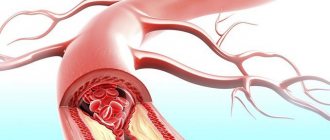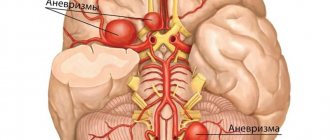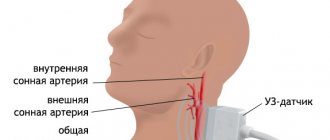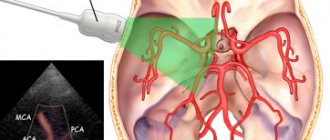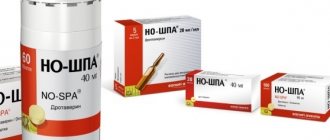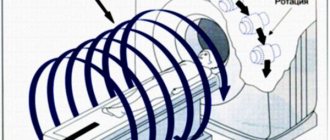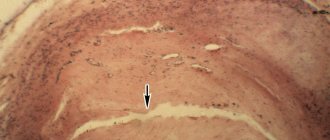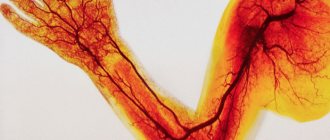Sclerosis of cerebral vessels is most common in people over fifty years of age. True, in recent decades, the first manifestations of pathology are increasingly being discovered at a younger age, sometimes even in 20-25 year olds. In addition, this disease is detected 5 to 7 times more often in male patients.
Vascular sclerosis
Sclerosis of the cerebral vessels is a disease that occurs not as an independent pathology, but as a consequence of sclerotic changes in the vessels throughout the human body. If the vessels supplying blood to the brain are affected, the patient begins to develop this disease. Unfortunately, in recent years this disease has taken a leading position in terms of frequency and severity of the consequences of the disease.
Sclerotic processes can develop in any human organ. For example, with their development, cardiosclerosis will be diagnosed in the heart, nephrosclerosis in the kidneys, osteosclerosis in the bones, and atherosclerosis in the blood vessels.
Principles of treatment
How to deal with cerebral atherosclerosis? Several approaches are used to eliminate this dangerous disease; with proper treatment, they will help avoid fatal symptoms and stroke.
Treatment in therapeutic departments is carried out in the early stages of the pathology, when the fibrous plaque can still be dissolved with the help of medications and dietary adjustments. Surgical treatment is performed when atherosclerosis significantly impairs blood flow and leads to organic disorders in the central nervous system. It is advisable to supplement the main activities with traditional medicine.
Therapeutic treatment
Medicines for cerebral atherosclerosis are represented by a wide range of drugs that affect the structure of the disease. The most relevant group includes drugs that have a lipid-lowering drug effect. These include:
- Statins, which reduce the number of receptors for LDL and provide enhanced uptake and processing of the “harmful” fraction by the liver. Drugs for the treatment of cerebral atherosclerosis, with long-term use, can reduce fibrous plaques and stabilize lipid metabolism in the body. The disadvantage of treatment with these medications is addiction, which is why they are prescribed for life. Contraindications for use are people with active hepatitis, liver cirrhosis, liver failure, and pregnancy. The group includes: Liplimar, Simvastatin, Fluvastatin.
- Fibrates increase the amount of enzymes that break down fats, reduce the amount of triglycerides, provoke the breakdown of LDL and block the synthesis of VLDL. These drugs reduce total cholesterol levels, but are prescribed only for hyperlipidemia due to the triglyceride fraction. Treatment of liver failure with these drugs is contraindicated. The group includes: Fenofibrate, Ciprofibrate.
- Bile acid sequestrants - substances promote enhanced excretion of endogenous cholesterol from the body with bile. There is practically no change in triglycerides, however, there have been cases of an increase in this fraction during treatment. Receptors for LDL also increase in the liver. Representatives of the group include: Cholestyramine.
- Nicotinic acid for atherosclerosis is used if a violation of fat metabolism occurs due to an increase in all lipid fractions. The drug reduces the synthesis of LDL and VLDL. With prolonged use, the amount of “good” cholesterol increases. The use of nicotinic acid for atherosclerosis leads to a decrease in the resistance of the muscular lining of the artery and the vessel dilates. The drug reduces the risk of blood clots forming on a ruptured cholesterol plaque and their migration.
In addition to the main medicine for cerebral atherosclerosis, multivitamin complexes and symptomatic therapy can be used. Among them:
- Antiplatelet agents, substances that reduce platelet aggregation. Treatment of cerebral atherosclerosis with a high risk of stroke necessarily requires the use of a combination of clopidogrel + acetylsalicylic acid (double antiplatelet load).
- For high blood pressure, antihypertensive drugs should be used. Drugs that relieve hypertension: Cozaar, Ramipril, Bisoprolol.
Preference should be given to combination medications. Also, for successful treatment, you should adhere to a diet and limit the intake of exogenous cholesterol from food.
ethnoscience
Herbs for atherosclerosis complement the main treatment and enhance the effects of tablets for dyslipidemia. Medicines are created from plants according to these recipes:
- Pour 300 ml of boiled water into crushed and dried plantain leaves in a dose of 1 tablespoon. The product is infused for 15 minutes. Then you need to drink the decoction in small sips 30 minutes before meals.
- Cut the strawberry leaf into small pieces and add hot water. The broth is infused for about 30 minutes. You can drink the resulting medicine 4 times a day, 1 tablespoon.
Atherosclerosis
With atherosclerosis, the walls of blood vessels are destroyed and then degenerate. As a result of this process, the vessel loses its elasticity, and the connective tissue grows, and plaques appear on its walls, which gradually lead first to partial blocking of the lumen for blood flow, and then to its complete blockage. This pathology can develop due to various reasons. It can be:
- hereditary factor;
- poor diet high in fat, often leading to obesity;
- diabetes;
- inflammatory processes;
- circulatory disorders;
- age.
A big problem with this pathology is the fact that it is almost impossible to start treatment at an early stage. This is due to the fact that the first symptoms begin to appear quite late, and cerebrovascular accident may already begin.
Sclerotic manifestations of brain damage
Brain tissue is extremely sensitive to lack of nutrition and oxygen, and a chronic lack of these components necessarily entails cell death. This situation can continue for quite a long time, and with an advanced form of the disease, a person first expects a significant decrease in the quality of life, and then complete disability.
Considering the complexity of diagnosing vascular pathology, noticing the first manifestations of the onset of cerebral sclerosis is also quite problematic. Even doctors quite often ignore symptoms without proper attention. This disease has three stages of development, and it is very important not to miss the beginning.
Initial stage of the disease
If you are careful about your health, a person should consult a doctor if the following warning symptoms appear, which are usually signs of cerebral vascular sclerosis:
- lethargy, drowsiness and fatigue;
- deterioration of memory and concentration;
- emotional instability and high excitability;
- ringing in the ears and spots before the eyes;
- regular short-term pain in the head;
- slight dizziness.
The main symptom, which is observed in almost 90% of patients, is headache attacks. It can be pulsating or pressing. The pain can occur at any time of the day and often interferes with normal sleep. Patients often note a feeling of fullness inside the skull and bursting pain. These manifestations quite often worsen with increasing mental or physical stress. Stressful situations and lack of oxygen in an unventilated room also have a negative impact. In some patients, the onset of pain is preceded by tinnitus and slight dizziness.
Second stage
As this disease progresses, all the symptoms that appeared at the initial stage begin to worsen greatly and become quite pronounced. The patient's intellectual abilities begin to suffer greatly - memory sharply decreases. A person remembers very well, down to the smallest detail, what happened a long time ago, but often forgets recent events. The patient's concentration is very low, and the person practically cannot understand the meaning of what he read. At this stage, the patient begins to forget his professional skills. Sometimes even reading becomes an extremely difficult task. In addition, to the obvious symptoms are added:
- noticeable disturbances in articulation and gradual loss of speech skills;
- difficulties arise when performing usual types of work;
- impaired coordination of movements;
- the person becomes very moody and irritable.
Third - deep stage of brain damage
The third stage of cerebral vascular sclerosis occurs with extreme aggravation of all previously existing symptoms. The patient receives complete or partial incapacity with disability. Such patients confuse names, remember practically nothing and often do not recognize their loved ones. Even the most basic skills become challenging.
The most deplorable outcome of cerebral vascular sclerosis are strokes, heart attacks and senile dementia or dementia.
Aortic sclerosis
Blockage of a main artery with cholesterol plaques
There are several types of cerebral sclerosis, one of them is aortic sclerosis. The blood vessel may be completely or partially affected. The initial symptoms of the disease are mild and nonspecific.
As the pathology develops, aneurysms - bulges in the form of sacs - begin to form on the aorta, which causes discomfort and pain.
The following symptoms develop:
- in the presence of cholesterol deposits in the upper part of the vessel, the pain syndrome radiates to the area of the shoulder blades and the upper part of the chest;
- if a person feels pain in the back, this indicates damage to the lower part of the aorta;
- with atrophic changes in the arch, unpleasant sensations radiate to the neck and shoulders.
In addition to these symptoms, facial swelling, migraines, and voice changes (hoarseness) are possible. Without the necessary examination and therapy, the aneurysm is likely to rupture, which will lead to death. If arterial hypertension develops along with the underlying disease, the prognosis worsens significantly.
Diagnosis of the disease using modern methods
Vascular sclerosis is a very complex and extremely unpleasant disease in its consequences. Based on this, it is extremely important to detect pathological changes at the initial stage and begin treatment as soon as possible. An attentive doctor, at the first suspicion, should prescribe a full examination of the person to confirm or refute his suspicions. During the first examinations, the doctor first conducts certain tests, compiles an anamnesis based on the patient’s complaints and prescribes general examinations of blood and urine.
To diagnose cerebral vessels, it is customary to use the following methods:
- Carrying out an ultrasound scan of the vessels that provide blood supply to the neck and head. During this procedure, the general condition of the vessels is established. An ultrasound is completely painless and harmless and can take about half an hour. Sometimes, instead of the name ultrasound, you can find the term “neurosonography” - these are the names of the same study.
- If the ultrasound findings are not entirely clear, the patient is prescribed a duplex examination. It has two modes:
- two-dimensional - such an examination gives a complete picture of the vessels approaching the head and all the tissues surrounding them; based on the results of the examination, the whole picture of the blood supply to the head becomes clear;
- transcranial - this diagnostic method is used to study the vessels that are located inside the skull.
- Angiography of blood vessels is carried out by injecting a contrast agent into them, which is clearly visible on x-rays. Based on the degree of filling with this substance, the doctor will draw a conclusion about the condition of the vessels of the head.
- One of the most accurate methods of such diagnostics can be considered magnetic resonance angiography, which can be performed both with and without the use of a contrast agent.
Based on the results obtained from all examination methods, the doctor will prescribe appropriate treatment.
Diagnosis of the condition
When a doctor examines a patient, he may detect symptoms associated with tendon reflexes, either increased or decreased. It happens that the skin loses sensitivity. This is also observed in those parts of the body for which areas of the brain susceptible to sclerosis are responsible. If the functioning of the cerebellum is disrupted, this will be manifested by unstable performance of certain tasks given by the doctor (Romberg pose and coordination tests). An ophthalmologist, during an eye examination, may also note that the vessels of the fundus are also subject to changes.
The diagnosis: cerebral vascular sclerosis is made by a doctor not only based on how the symptoms appear. To carry out treatment, medical hardware diagnostics are needed. Usually this is ultrasound (neurosonography), duplex scanning of the cervical and cerebral vessels. It shows how they have changed in diameter under the influence of manifestations of sclerosis, how difficult the passage of blood is. Research is:
- β-mode, two-dimensional, with a visual color and spectral illustration of vascular blood flow. This is an image along and across the vessel, with the exception of the intracranial one.
- Using the Doppler effect (the frequency and length of the wave radiation changes when either the assessor or the patient moves), different hemodynamic readings in the vascular system are assessed.
- Transcranial, as a variant of duplex, allows you to look inside the skull and examine the vessels there. It reveals the intensity of blood flow, the area of brain damage, location in a particular hemisphere, the presence of hematomas, etc. It also monitors changes in the course of the disease.
Such studies do not cause any discomfort to the patient and take ⅔ hours. Immediately after completion of the procedure, a conclusion is issued.
Angiography is useful for confirming the diagnosis. During this procedure, a substance is injected that shows (on x-rays) how thick the vessels are with the presence of atherosclerotic plaques.
An effective method for viewing the picture of a lesion is magnetic resonance and computed tomography of cerebral vessels. They can be performed without a contrast agent if you are allergic to it.
Laboratory biochemical blood tests for cholesterol, LDL, HDL, triglycerides (lipid spectrum) usually show an imbalance between the presence of good and bad cholesterol with an increased content of the latter in the blood plasma.
Methods of treating the disease
If the diagnosis is confirmed, the treatment method will use two main directions:
- Slowing down the process of sclerotic changes in the patient’s vascular system.
- Stimulating additional nutrition to the brain by developing less active blood flow pathways to the patient's head.
First direction
The basis of this direction is the desire to stop or slow down the progression of atherosclerosis. The main thing that the patient himself must do is to completely change his eating style, and indeed his entire life routine.
Diet
Based on the diagnosis, the doctor will offer the patient a diet that will need to be strictly followed for the rest of his life. This is the so-called anti-cholesterol diet, which implies a diet balanced in the content of animal and vegetable fats, as well as the presence of the required amount of vitamins. For this purpose, it is necessary to include fish or any seafood and plant foods as much as possible in the diet. Flour products, fatty meats, smoked meats, pickles, and eggs should be included in the menu as rarely as possible. In addition to the composition of the menu, for people with excess body weight it is very important to monitor the reduction in caloric intake.
Drug treatment
In addition to changes in diet, the patient is also prescribed medication, which includes drugs:
- improving blood supply, and therefore nutrition of the brain, these can be drugs that dilate blood vessels and reduce blood viscosity;
- to slow down the development and treatment of atherosclerosis - normalizing lipid metabolism, inhibiting the formation of cholesterol, maintaining the elasticity of the walls of blood vessels;
- helping the brain function - stimulating brain activity, increasing cell survival in conditions of lack of oxygen;
- aimed at treating concomitant diseases - hypertension, diabetes, liver diseases, etc.;
- vitamin complexes;
- immunomodulatory drugs.
Second direction
All methods and techniques that are included in this group are aimed at stimulating all additional vessels to improve the circuitous blood supply to the patient’s brain. This may include physical therapy and continuous physical activity, as well as physical therapy.
Physical activity
People suffering from cerebral sclerosis should pay great attention to sufficient daily physical activity. Almost everyone knows the need for walks in the fresh air. In addition, the doctor will prescribe courses of physical therapy taking into account the age and general physical condition of the patient.
Physiotherapy
Quite often, in addition to physical therapy, the patient is prescribed various physical procedures - massage, magnetic therapy, balneotherapy, etc. All these procedures should be aimed at relieving pain and improving blood flow, which helps treat vascular sclerosis. In addition, metabolism and blood pressure normalization will be stimulated.
Treatment: basic methods
Pharmacy drugs
How and with what to treat sclerosis developing in the vessels of the brain is chosen by the doctor personally for each patient. Many pills and other medications have side effects, so using them on your own is strictly prohibited. The most effective drugs are presented in the table:
| Medication group | Name |
| Lipid-lowering drugs | "Atorvastatin" |
| "Rosuvastatin" | |
| "Lovastatin" | |
| "Atorvastatin" | |
| "Fluvastatin" | |
| Nootropic substances | "Actovegin" |
| "Glycine" | |
| "Piracetam" | |
| Drugs with vasoactive effects | "Cavinton" |
| "Cinnarizine" | |
| "Vinpocetine" | |
| Antispasmodic medications | "No-shpa" |
| "Baralgin" | |
| "Spazmolgon" | |
| Medicines that relieve inflammation | "Diclofenac" |
| "Ibuprofen" | |
| "Nurofen" | |
| "Nise" | |
| Fatty acid | "Linetol" |
| "Eikonol" | |
| Thioctic acid |
Physiotherapeutic procedures
Physiotherapy, which includes a procedure such as balneotherapy, will help relieve symptoms.
Comprehensive treatment of cerebral vascular sclerosis includes the use of physiotherapy, which is prescribed by a doctor. Ozone therapy and other similar methods of therapy are not fully capable of coping with the deviation, but they help alleviate the symptoms of the disease and activate metabolic processes in the cells of the organ. For this purpose, the patient is prescribed the following physiotherapeutic procedures:
- balneotherapy;
- massotherapy;
- magnetic wave treatment;
- ozone therapy.
Do folk remedies help?
When treating choroid plexus sclerosis of the brain, diet and other therapeutic methods can be supplemented with natural ingredients. Young garlic and honey, which can be consumed in their pure form, have a positive effect on the patient’s condition. Other folk remedies for cerebral vascular sclerosis also help:
- dill seeds;
- valerian root;
- hawthorn berries;
- dandelion leaves;
- onion peel;
- rose hip;
- stinging nettle;
- yarrow;
- rowan bark.
Surgical intervention
When blood vessels are blocked, surgical intervention is used, one type of which is stenting.
As complications of choroid plexus sclerosis progress, surgery may be required. Radical therapy is required when most of the artery is blocked. Surgery can be performed in several ways:
- endarterectomy with excision of damaged walls and further removal of blood clots;
- stenting, in which a stent is inserted into the artery to widen the lumen.
How important is diet?
Patients diagnosed with sclerosis require special nutrition. It is recommended to stick to table No. 10 according to Pevzner. Be sure to avoid chicken egg yolks, fish roe, crayfish, liver, and beef tongue. It is worth adding the following products to your diet:
- various citruses;
- oatmeal jelly;
- nuts, especially almonds;
- legumes
Green tea, which lowers cholesterol, has a positive effect on the condition of a patient with cerebral vascular sclerosis.
Surgery
Sometimes, during an examination, the doctor discovers a blockage of the main vessels by more than 70%. In such cases, the patient receives a referral to a surgeon for a consultation. It is the vascular surgeon who makes the decision about the need and possibility of surgical intervention. Surgery is almost always necessary when the patient’s life is at risk. Most often, the doctor will try to remove overgrown plaques or part of the affected vessel. In addition, the stenting method has recently become widespread - a stent is inserted into the vessel to the affected area and the lumen is expanded. This will not cure vascular sclerosis, but will significantly improve blood supply to the brain.
Preventive actions
Knowing about the possibility of such a disease, it is important to follow a number of rules throughout your life that will help you avoid these problems. Prevention of sclerosis does not require any special measures, but the difficulty is that this should be a mandatory and unchangeable habit. Need to:
- lead a physically active lifestyle;
- spend a lot of time outdoors;
- alternate mental work with physical activity as often as possible;
- Constantly monitor blood pressure and sugar levels;
- proper rest and sleep;
- Constant memory training is important;
- balanced diet;
- complete cessation of bad habits.
From all of the above, we can conclude that only an integrated approach to treating the problem that has arisen will give a good effect. It is important for the patient to combine drug treatment with sufficient physical activity, proper nutrition and physiotherapy. Only by using everything in combination can you achieve good results in treatment and achieve improved well-being and lasting remission.
Sclerosis of cerebral vessels: symptoms, treatment (groups of drugs), prevention
From the article you will learn the features of cerebral sclerosis, the causes of the development of pathology, the danger of complications, methods of diagnosis, therapy and prevention.
Sclerosis of cerebral vessels is a pathological process associated with changes in the structure of the vascular wall, loss of its elasticity, the formation of atherosclerotic plaques, narrowing of the lumen of blood vessels and disruption of the transport of nutrition and oxygen to tissues and organs.
General information
With age, a person experiences irreversible disturbances in the functioning of organs and systems. After reaching the age of fifty, cerebral vascular sclerosis is often observed. Although signs of the disease are not uncommon in young people aged 20–25 years. Representatives of the stronger sex are most often susceptible to this disease.
The main reason for such failures is the formation of cholesterol plaques on the inner wall of blood vessels. The mechanism of action of the pathology is that these deposits do not allow the vascular system to transport oxygen and other useful substances to the brain cells in the volume they need.
Causes of pathology
Sclerosis of the cerebral vessels with its characteristic symptoms can be provoked by diseases that give rise to the accumulation of such deposits in the blood. The provocateurs of negative processes are:
- heredity;
- blood pressure disorders;
- disruptions in the endocrine system (thyroid, pancreas);
- obesity;
- bad habits (smoking and alcohol);
- abuse of animal products;
- physical inactivity;
- heart diseases;
- dysfunction of the hemostasis system, causing increased blood coagulation;
- damage to the body by viruses;
- infectious pathologies that cause weakening of the walls of blood vessels;
- inflammatory reaction with prolonged fever.
Risk factors
Factors that can be changed Factors that cannot be changed
| Overweight | Male |
| Sedentary lifestyle | Age over forty |
| Low mental activity | Congenital disorders of fat metabolism |
| Smoking | Inflammatory liver diseases |
| Alcoholism | Diabetes mellitus types 1 and 2 |
| Drug use | Disturbances in the absorption of fats and carbohydrates |
| Disturbances in sleep and rest patterns | Reduced levels of enzymes in the body |
| Drinking carbonated drinks | Increased blood pressure |
| Excess fatty and fried foods | Chronic diseases of the gastrointestinal tract |
Classification
Depending on the root cause and degree of damage, 2 forms of vascular sclerosis are classified:
- progressive;
- cerebral.
To effectively eliminate cerebral vascular sclerosis, adequate treatment must begin as early as possible. Pathology can have 3 degrees of damage.
initial stage
Warning symptoms:
- noise in ears;
- constant lethargy;
- fatigue;
- slight dizziness;
- drowsiness;
- memory lapses;
- high excitability;
- minor headaches.
Most often, at the initial stage of lesions, 90% of patients experience headaches of varying degrees of intensity (pressing, bursting, throbbing). Such discomfort bothers a person at any time of the day and often interferes with normal sleep. With increased mental and physical stress, these symptoms worsen.
Second stage
If the process is not stopped, the pathology becomes more serious. Because of the problem, the intellect suffers, which is expressed in poor memory and inability to concentrate. In this phase, the patient begins to forget even basic professional skills. Added to these manifestations are:
- coordination problems;
- speech loss of varying severity;
- irritability.
To prevent such an effect, it is important to promptly notice any deviations in the natural state and urgently get rid of the disease.
Third
This is the most complex degree of vascular damage. The patient receives partial and complete incapacity, disability. This is due to the fact that patients cannot take care of themselves and are unable to read or speak.
Symptoms and clinical manifestations
Sclerotic changes in the blood vessels of the brain have a fairly clear clinical picture, which fits well into the diagnostic framework. Based on complaints, an experienced diagnostician is able to make a preliminary diagnosis and send the patient for diagnosis to a specialist as soon as possible.
General symptoms of cerebral vascular sclerosis: headaches, dizziness, nausea and vomiting, fever, weakness, sweating, changes in exercise tolerance, increased fatigue, sleep disturbances (waking up at night, insomnia).
Specific symptoms of the disease:
- gait disturbances (lameness, waddling gait);
- hearing pathologies (noise, ringing in the ears);
- increased blood pressure;
- fainting and loss of consciousness;
- decreased vision;
- migraine;
- the appearance of dark spots before the eyes;
- increased aggressiveness and irritability;
- apathy and depression;
- neck pain;
- sensation of pulsation in the head;
- speech and writing disorders;
- memory loss;
- episodes of amnesia;
- sensations of numbness in the upper and lower extremities;
- disturbances of concentration and attention.
Is such vascular damage dangerous?
The cerebral and progressive type of vascular sclerosis, if left untreated, is dangerous to human life. This condition is fraught with impaired blood supply, which leads to hypoxia, which provokes ischemia of tissue cells. Patients often suffer from strokes. They undergo the following changes:
- the central nervous system is affected;
- vision decreases;
- the reaction to light and sound is dulled;
- hearing deteriorates;
- tremor of the limbs appears;
- facial symmetry is disrupted.
In order not to worsen the condition, preventive measures and timely contact with a qualified specialist who knows how to get rid of sclerosis that has begun are important.
Diagnostics
If you observe any of the above symptoms and complaints, a person should contact a neurologist, who will prescribe the necessary examination, select appropriate therapy and monitor the subsequent development of the disease, which will affect the patient’s condition.
Making a diagnosis of cerebral vascular sclerosis and identifying the degree of development of the disease is usually made through the use of ultrasound methods:
- Ultrasound of the blood vessels of the brain and neck - with this ultrasound examination, the condition of the blood vessels that are located outside the head and neck, as well as inside the skull, is checked. This procedure is quite safe and does not cause any discomfort to the patient. Its duration is about 40 minutes; upon completion of the tests, the doctor issues a protocol with his conclusion. Sometimes ultrasound of cerebral vessels can be called neurosonography (this name is often found).
- Duplex scanning is one of the components of a full-fledged vascular ultrasound; it is usually carried out in several modes:
- Two-dimensional (B-mode) - allows you to perfectly view the vessels and surrounding tissues, except for those located inside the skull. Thanks to this mode, the doctor can find out about the state of blood flow in the vessels of the head.
- Transcranial duplex scanning - it is used to study the blood flow in the vessels inside the skull. Transcranial ultrasound can also be used to examine the brain substance for the presence of space-occupying formations. But the information content of this technique is inferior to computer and magnetic resonance imaging of the brain.
- Angiography of cerebral vessels using a contrast agent. The method of its implementation is as follows: a radiopaque substance is injected into the vascular bed and at the same time several X-ray images are taken.
- One type of vascular angiography is magnetic resonance angiography (MR angiography or MRI angiography) - a research method based on the use of magnetic fields and electromagnetic waves. MR angiography can be performed in several ways - with or without the introduction of a contrast agent. Which is especially valuable for patients with allergies to contrast agents.
Features of therapy
For sclerosis treatment to be successful, it must solve 2 main problems:
- prevention of further formation of atherosclerotic plaques;
- formation of bypass pathways for blood flow.
To cope with the above tasks, first of all, it is necessary to devote all efforts to treating concomitant diseases (especially hypertension and diabetes) and maintaining a diet.
Proper nutrition for multiple sclerosis
People suffering from sclerosis need to follow a diet: avoid smoked meats, fatty meats, liver, kidneys, eggs, chocolate, sorrel; limit consumption of salt, baked goods and pasta; increase the content of plant foods, dairy products, cereals, fish and seafood.
Green tea, lemon and grape juice, parsley, cabbage, cucumbers, zucchini, green peas, carrots, garlic, onions, rowan berries, rose hips, apples, pomegranates, walnuts, sprouted grains, oatmeal are especially useful for lowering cholesterol levels and cleansing blood vessels in the brain. , seaweed, vegetable oils.
On an empty stomach, it is recommended to drink a glass of hot water or juice obtained from raw potatoes.
Good rest and sleep, avoidance of anxiety and overwork, as well as therapy with traditional methods are important in the fight against sclerosis.
Under no circumstances should you self-medicate so as not to worsen the situation. In each specific case, the attending physician selects medications individually, taking into account the patient’s age, stage of the disease, symptoms, and the presence of concomitant diseases.
Medicines
Drug treatment for sclerosis includes the use of:
Benefits of Physiotherapy
An effective effect in the fight against sclerosis will be provided by a complex of physical therapy, which must be selected individually for each patient in accordance with his capabilities, and physiotherapeutic procedures: massage, balneotherapy, magnetic therapy.
Exercise therapy
Pay attention to global recommendations for exercise therapy for patients with a similar diagnosis. Exercises must be dosed and adequate, so they are selected strictly on an individual basis.
The main goal of physical activity is to improve the patient’s condition without causing any aggravation of the problem. Special exercises will help clear blood vessels from sclerotic plaques. Exercise therapy includes the following exercises: turns, bends, rotations, limb lifts, somersaults.
A simple exercise will help improve the activity of blood vessels - alternately standing for some time on one of the legs. Ordinary walking in the fresh air also perfectly improves the functioning of blood vessels. You need to select exercises with a cardiologist so as not to harm the body. It is highly undesirable to engage in rowing or running.
Surgery
If a patient’s vessel is blocked by more than 70%, he is referred for consultation to a vascular surgeon. The doctor examines the patient's condition and makes a decision on the need for surgical intervention.
Surgical treatment is aimed at removing fibrous plaques and blood clots.
During the operation, the following is used: endarterectomy - the wall of the affected artery is cut and the thrombus is removed, stenting - a stent is inserted into the vessel, expanding the lumen.
Consequences
Advanced sclerosis leads to severe complications:
- First of all, the patient’s attention decreases and memory suffers. A person cannot perform usual actions, does not orient himself in space, and can easily get lost among familiar streets.
- Along with memory loss, dementia develops. Elderly people are more likely to experience this complication. The patient does not understand the consequences of his own actions, and there is a gradual decline in intelligence.
- Another danger lies in the development of stroke and thrombosis, recovery from which requires a long time. But often pathologies become the cause of death.
- According to statistics, about 50% of patients after a stroke are considered disabled. In 40% of cases, death is diagnosed. And only 10% are sufficiently rehabilitated and regain their working capacity.
To prevent such developments, it is necessary to prevent sclerosis from an early age. It is advisable to monitor your weight, avoid eating foods harmful to the circulatory system, adhere to a healthy lifestyle and practice feasible physical activity.
Prevention
The following will help prevent cerebral vascular sclerosis:
- balanced diet;
- rejection of bad habits;
- active lifestyle;
- maintaining normal blood pressure;
- prevention of stressful situations, physical and mental fatigue;
- quality sleep and proper rest;
- regular memory training (learning foreign languages, memorizing poetry).
Sources: vsepromozg.ru, sosudinfo.ru, prososud.ru
Last updated: January 5, 2020
Source: https://sosudy.info/skleroz-sosudov-golovnogo-mozga
